Planeswalker's Guide to Eldraine
Welcome to Eldraine, Planeswalker! Here, let us show you around
The Realm
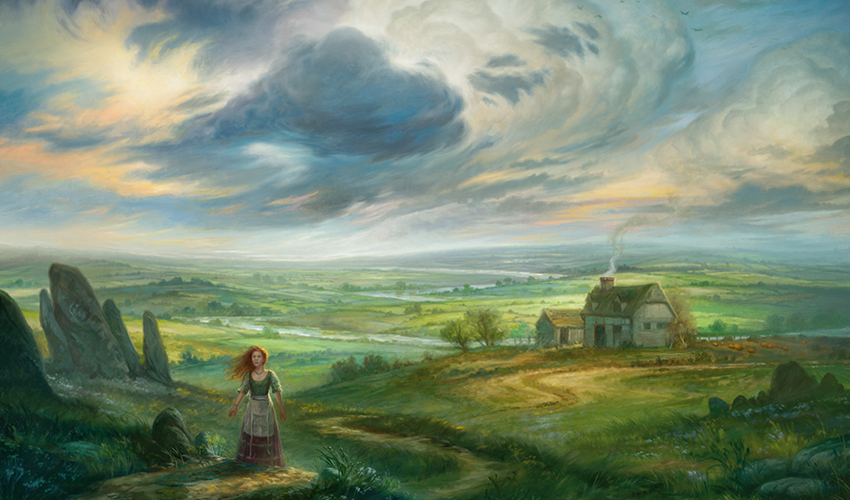
The multiverse is home to many beautiful vistas and picturesque countrysides, but few are as tranquil as those found in the realm of Eldraine. On most days, life in the realm is simple and calm, and the folk who call it home, mostly humans, like it that way.
But the realm is far more than a relaxing getaway, it is also a grand stage upon which any virtuous soul can prove their worth and rise to glory. Achievement in the realm is rewarded with fortune, respect, and position. Though some denizens of the realm may be suspicious of mysterious travelers, I have found that even a visitor from another world can rise to nobility should they wish to seek it.
Most of the realm is small hamlets and farmland, but it is ruled over by five royal courts: Ardenvale, Vantress, Locthwain, Embereth, and Garenbrig. These courts serve and protect the people of the realm and uphold their fundamental virtues. The five courts are mostly independent states, but they are unified as one realm under the rule of the High Throne. Though they may harbor fierce rivalries on the tournament grounds, they are rarely in open conflict with one another and have never openly been at war.
History
Before the rise of humanity, elves ruled the land that is now the realm. Legends say that in ancient times the woods had no borders and its wild growth stretched as far as the eye could see. The five relics that now form the centers of the courts were elvish treasures back then, and it's even possible that elf magic created some of them. Eight or nine generations ago, humans rose to power and drove the elves out of what would become the realm. The woods itself retreated with them, creating the divide between the realm and the wilds that Eldraine has known in the centuries since.
The relics themselves are wondrous, mysterious objects with immense magical power and a sentience that lies just beyond mortal understanding. What is known for certain is that each of the five relics is the physical embodiment of one of five virtues and possesses the power to judge that virtue within individuals. In the realm, the virtues of the relics (and their judgement) are considered objective and inarguable, and it is this infallibility around which all of realm society is built.
Virtues
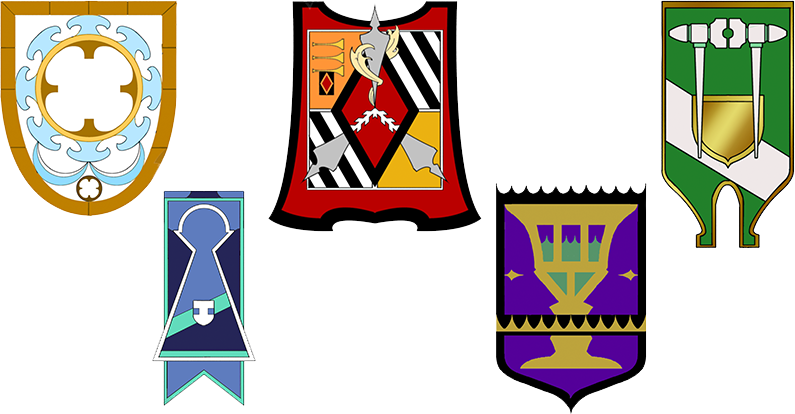
Life in the realm revolves around five fundamental virtues: loyalty, knowledge, persistence, courage, and strength. All denizens of the realm, be they knights, nobles, or peasants, strive to uphold these virtues in their everyday life. When a person in the realm wishes to compliment or insult another, they will often cite their success or failure to live by one virtue or another.
The five virtues are established by the five relics and are thusly treated with absolute respect and authority. The denizens of the realm see all the virtues as ideals to strive for, but not always equally. Naturally, each court believes the virtue associated with their own relic is paramount, though, not in lieu of the others. A knight of Embereth will admire your courage above all else but still look down upon the disloyal or foolish.
Knights
In the realm, knighthood is among the highest honors one can receive. Knights are revered as champions, heroes, and paragons of virtue. Knights of the realm, who are all addressed with the honorific "Syr," have many responsibilities, from protecting innocent townsfolk to going on daring adventures in the wilds. Knights are often equipped with finely crafted armor and weaponry, ride noble steeds of various size and species, and occasionally wield powerful magic drawn from the relic of their respective court.
Achieving knighthood in one of the courts means taking on a quest to prove excellence in that court's virtue. In some courts, the final step to becoming a true knight involves being judged by that court's relic.
The High Throne and the Great Quest
About once a generation, a mysterious creature called the Questing Beast chooses an extraordinary knight to undertake a grueling challenge, called the Great Quest, to claim the High Throne of the realm. Those seeking the High Throne must achieve knighthood from all five of the realm's royal courts, proving they are virtuous enough to be worthy of the loftiest position in the realm. In the last fifty years, two individuals have been charged with the High Quest: the current High King Kenrith and his wife, Queen Linden of Ardenvale. I've been told by locals this is quite unusual, though, to be honest, a talking three-headed beast determining monarchy is pretty unusual to begin with.
Ardenvale
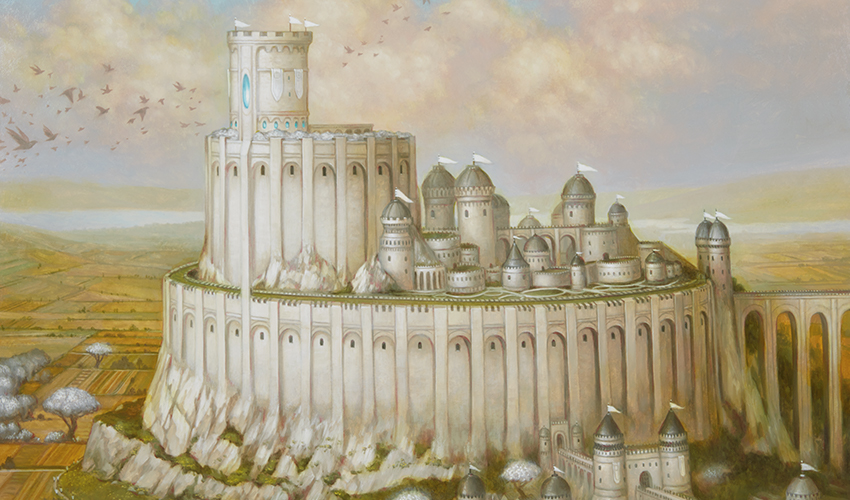
Perched on top of a hill overlooking the pastures and fields of the realm is Castle Ardenvale. Within its great white walls are acres of manicured lawns and precise, lush gardens. Near the top of the castle's central tower, the Circle of Loyalty is protected by dozens of loyal guards.
Ardenvale is a beacon of peace in the realm, standing as both a symbolic and literal object of power. Merely speaking its name is thought to weave subtle magic of protection around the speaker and their allies. The castle is home to both High King Kenrith and Queen Linden, along with their four children: Rowan, Will, Hazel, and Eric.
Loyalty
Ardenvale is built upon the core virtue of loyalty. The court sees loyalty as a foundation of kinship and trust that supports the other virtues, not merely a slavish obedience to whoever happens to be in charge.
Without the ability to trust and support others with loyalty, there can be no true harmony among people, and without harmony, there can be no true virtue. Ego is the enemy of loyalty, because it undermines that foundation of trust and harmony. Thus, Ardenvale knights strive to perfect their virtue by forsaking selfish thoughts and desires.
Knights
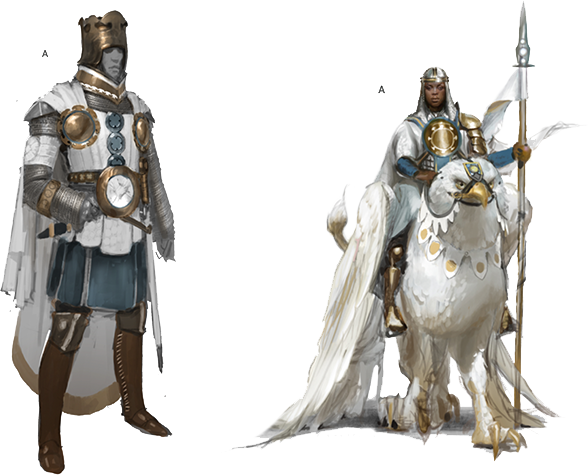
The knights of Ardenvale are loyal above all else—not just to its rulers, but to each other, and to the entire community that makes up the court. A true knight's loyalty trumps any sense of arrogance or self-importance: victory belongs to the group, not to any individual member, and even a lone knight's glory accrues to Ardenvale as a whole.
Ardenvale knights are fierce in battle, and all the more so when fighting in a group. They rarely quest alone, and loyalty means that no knight is ever left behind in the clutches of the enemy. When not engaged in battle or questing alone in the wilds, Ardenvale's knights love to gather at the court for company and conversation, treasures they value above all others.
Travelers who seek to make a positive difference in the world need look no further. As defenders of the realm, Ardenvale knights are often dispatched to protect innocent townsfolk from all manner of magical danger both near and far. Ardenvale's loyalty to the realm means they're often the first to be asked for help by the other courts in times of crisis.
The Circle of Loyalty
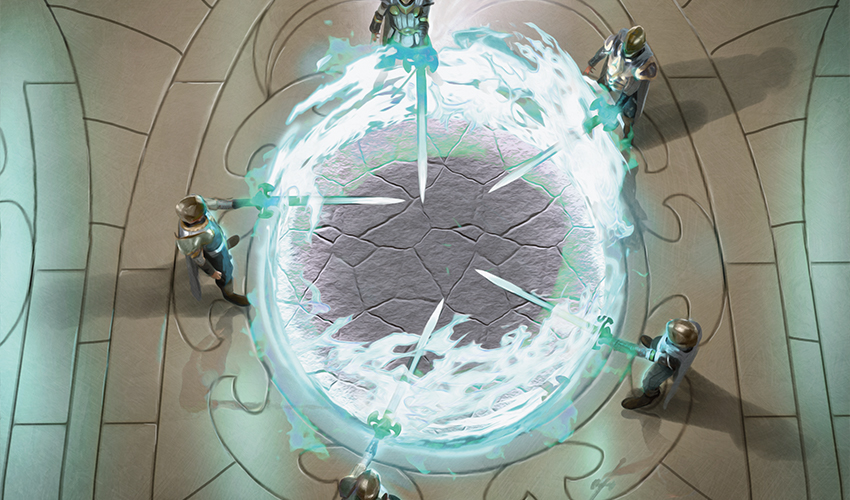
At the heart of Castle Ardenvale is a magical ring of eternally burning silver fire known as the Circle of Loyalty. To be named a knight of Ardenvale, aspirants must walk through the flame, for its magic can detect selfish people and prideful motives. Those who pass through the flame unscathed are deemed worthy and knighted at the center of the ring itself. Those who are burned are quickly pulled out and healed, but rarely are they allowed to attempt the trial a second time.
The Circle of Loyalty imbues knights and mages of Ardenvale with the power to heal their allies and smite their enemies with holy fire. The magic of loyalty is stronger when cast in groups and forges an unseen bond between knights that innately empowers them to protect one another. Oaths that invoke the Circle are imbued with magical certainty, and any who would dare break such an oath are cast out of Ardenvale at once.

Queen Linden, the Steadfast

The Queen of Ardenvale was a strong contender for the High Throne: by the time she was 25, she had become a knight of Vantress, Locthwain, and Ardenvale. She met her future husband amidst their questing, and the peculiarity of their circumstance—two knights undertaking the High Quest at the same time—drew them together. They fell in love, and they were married shortly after High King Kenrith completed the High Quest and ascended to the throne. Linden found a greater purpose in raising the twins Rowan and Will, though she would still go on to ascend to the throne of Ardenvale, ruling the court alongside her husband.
Unflinching in crisis, Queen Linden is revered by her subjects as a responsible and practical leader. It appears every town I've visited on my travels through the realm has at least one story to tell of Queen Linden's service, be it settling domestic disputes or resolving a conflict with the wilds. Knights often speak of her glory days of questing; her four knighthoods are still quite impressive in a world where few manage to achieve even the first.
Vantress

Castle Vantress rises like an island up from the surface of Lochmere, a mist-shrouded lake in a remote part of the realm. Banners and pennants fly from its spires and water flows freely throughout the fortress like an elaborate fountain. The castle rests on top of a large shaft that is normally full of water. At the bottom of this shaft is a dim, cave-like space where the Magic Mirror rests.
Castle Vantress is renowned as a center of scholarship in the realm, and researchers and questioners from the other courts often make the difficult journey to Vantress to find information that can't be found anywhere else.
Knowledge
Vantress knights believe that knowledge is the highest virtue. Knowledge directs the proper application of every other virtue in varied circumstances and helps to prevent problems from worsening into deeper problems.
Knowledge extends beyond the mastery of facts. A scattered collection of disjointed information is not knowledge, but trivia; true knowledge lies in the ability to synthesize disparate facts to derive a greater understanding of systems and principles. The enemy of knowledge is not just ignorance but rigid thinking and hidebound traditions. The knights of Vantress must be able to adapt their understanding of the world based on new information and new ideas.
Knights
In Vantress, knighthood is knowledge applied to the challenges of the world. To become a knight, an aspirant must tell the Magic Mirror a secret it did not already know, and even then, the gift of knighthood is bestowed at the Mirror's inscrutable discretion.
Once that gift is bestowed, the knights of Vantress continue to seek out new secrets for the Mirror, but they also venture out into the world and the wilds to put their knowledge to use. Many of them strive to help those who are in need of knowledge. When someone is stumped by a faerie's riddle, can't bypass an enchanted door, or is enthralled by witchcraft, a knight of Vantress might arrive to help them out of their predicament.
Loremages
Vantress wizards (often called loremages, chroniclers, or riddleseekers) seek out the lore of the wilds and dig into the secrets of the convoluted magic of the fair folk. They are surprisingly daring and well-traveled scholars; it is not uncommon for knights of every court to journey into a remote swamp or delve a firefly-lit cavern and find a loremage of Vantress already there. Vantress wizards are experts in contracts with supernatural beings, resolving transformations, and the terms and consequences of faerie promises; they routinely spout off counterexamples, exceptions, and special conditions. A word of warning: when you consult a chronicler of lore, be prepared to endure her answers in exhaustive detail.
The Magic Mirror
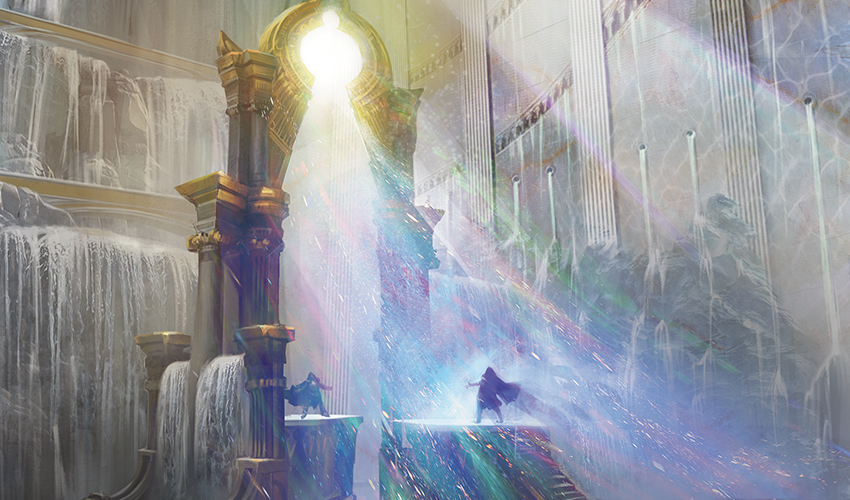
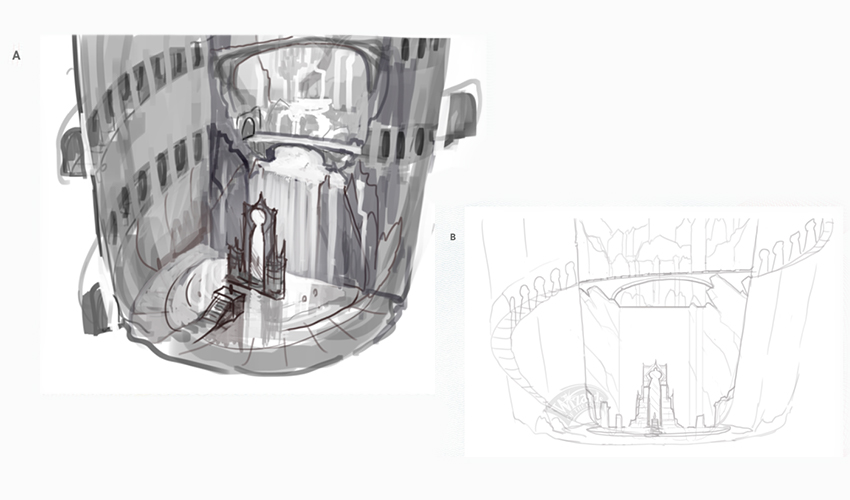
Far under Castle Vantress, often submerged in water, is the secret-hoarding Magic Mirror. Its true name is Indrelon, though only those who reside in Vantress call it by that name. As the story goes, in ancient times, the world's most foolish redcap asked a question of the world's wisest sage. The sage reflected on this question for the rest of his life, never finding an answer. After his death, the question magically remained, swirling in on itself, and the Mirror took form. The question is unknown to all but the Mirror itself, but to this day the Mirror sends Vantress loremages and knights out on quests to gather mystical secrets so that one day it might piece together the answer.
The mirror rewards the virtue of knowledge in all who come before it. The granting of knighthood is the most common reward, but even established knights bring new secrets to the Mirror in the hope of winning additional rewards in the form of magical boons and powers. Likewise, merfolk who have no aspirations to join the court of Vantress come before the mirror in hope of learning its secrets. The full extent of the Mirror's power is unknown, but the scope of its knowledge is undeniably vast.
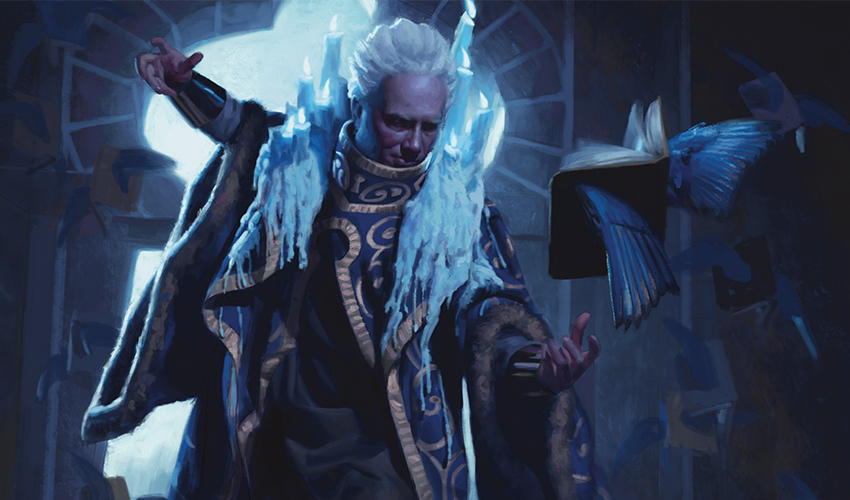
Unlike the other courts, Vantress has no official ruler. Instead, the people of Vantress are led by the Magic Mirror itself. Still, taking the orders of a sentient magical object that spends most of its time underwater can be quite a challenge, so most of the day-to-day responsibilities tend to fall on one or two notable Vantress loremages under the title of archmage. It takes a finely tuned mind to both earn the Mirror's respect and decipher its often-cryptic instructions, so the position of archmage is regarded with a level of respect reserved for the monarchs in other courts. Though, in the words of Gadwick, Vantress' current archmage, he "rarely [has] time for that kind of theatrics."
Locthwain
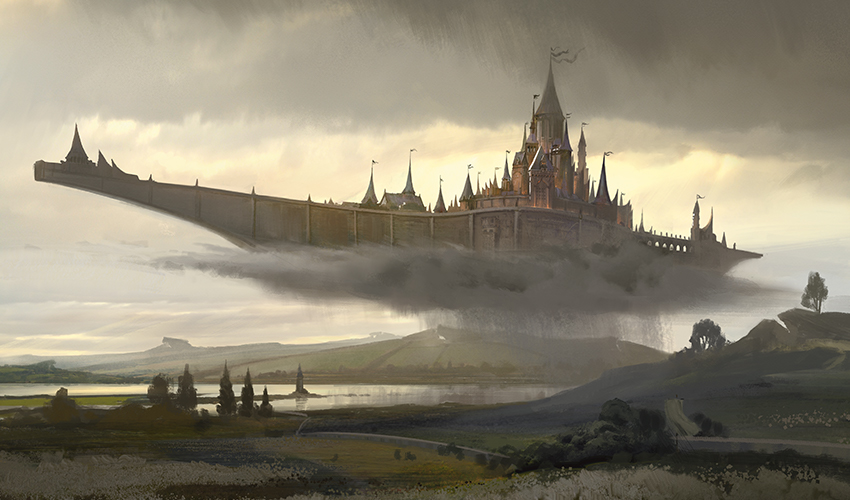
Castle Locthwain itself is a mobile, flying fortress—an enormous structure floating on rainclouds, constantly moving. The weather beneath the castle varies between a light drizzle and a thundering storm, depending (or so it is said) on the mood of its queen. It can settle down to earth, either on land or water, and the same magic that holds it aloft can lower its knights down to the ground on smaller, temporary rainclouds.
The interior of Locthwain is a labyrinth of narrow passages connecting great halls. Knights from other courts who have wandered in the maze have compared it to the wilds, suggesting that elven magic contributes to the sense of disorientation and, eventually, terror that claims those who become lost in the castle.
Persistence
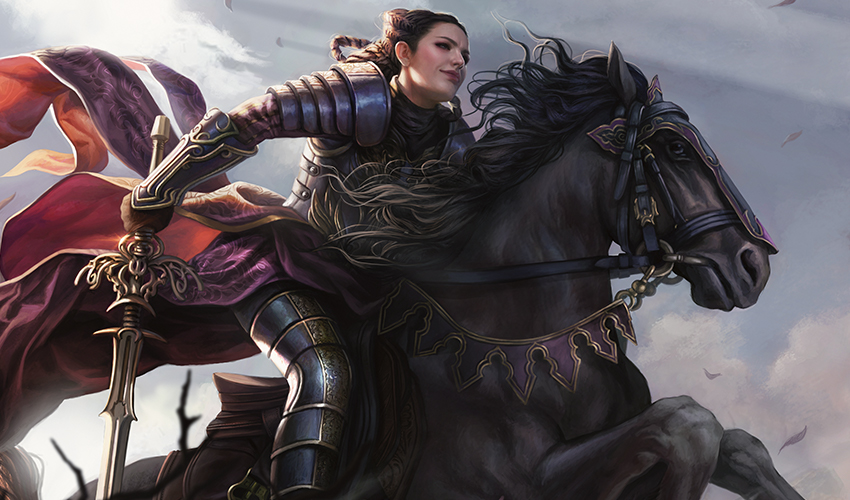
In the view of Locthwain, persistence is the highest virtue because it directs and marshals the other virtues toward a purpose. In Locthwain, persistence means determination, purposefulness, commitment, tirelessness, the stubborn refusal to give up.
While they are respected in their own right, the question of why they are not knights seeking the Cauldron always haunts the nobles of Locthwain. As one knight said to me: "The persistent pursuit of wealth, persistent efforts at building relationships with other courts, persistent efforts to serve the queen in her court—these are respectable manifestations of the highest virtue, but surely the quest for the Cauldron is the best use for such dedication!"
Knights
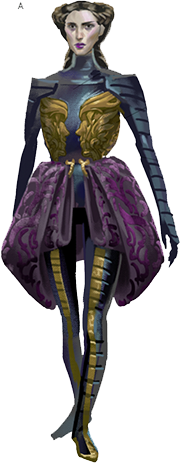
The knights of Locthwain are haughty, believing themselves superior to other knights by their devotion to the highest virtue. They are pragmatic enough to flee a losing battle, but their persistence ensures that they will find some way to return and defeat their enemies. A word of caution: avoid making an enemy of a Locthwain knight over trivial matters, as they are famous in the realm for holding lifelong grudges.
Even armored, Locthwain's knights always look ready for one of their queen's elaborate parties. The highest aspiration for a Locthwain knight is to become worthy of undertaking the quest for the Cauldron of Eternity—and wed the queen before setting out on the quest. In the meantime, they prove their worth questing for other magical gifts to curry favor with her.
The Cauldron of Eternity
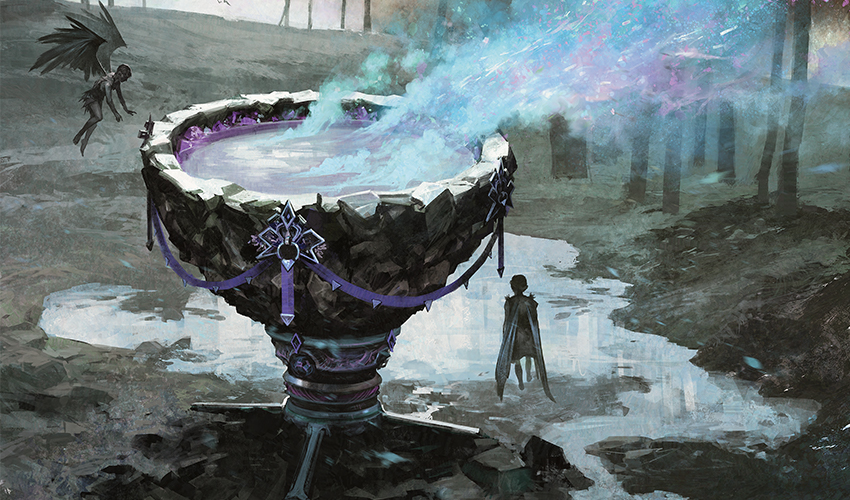
The Cauldron of Eternity is said to be a huge stone cauldron with the power to bestow everlasting life and restore life to the dead, so long as it finds them worthy. These claims seem consistent with what is known of the other four relics and explain the magic over life and death wielded by Locthwain warlocks. But, ultimately, these stories are unverifiable, for the Caldron of Eternity has been missing for many generations.
When elves ruled the realm, Castle Locthwain sat atop the cave where the Cauldron of Eternity was housed. But when humans took over the realm, the Cauldron was lost to the wilds. I've been told that each castle's relic anchors it morally, magically, and, also, literally. Thus, Locthwain remains airborne, wandering the realm as Ayara and her knights seek to recover their lost relic age after age.
Queen Ayara
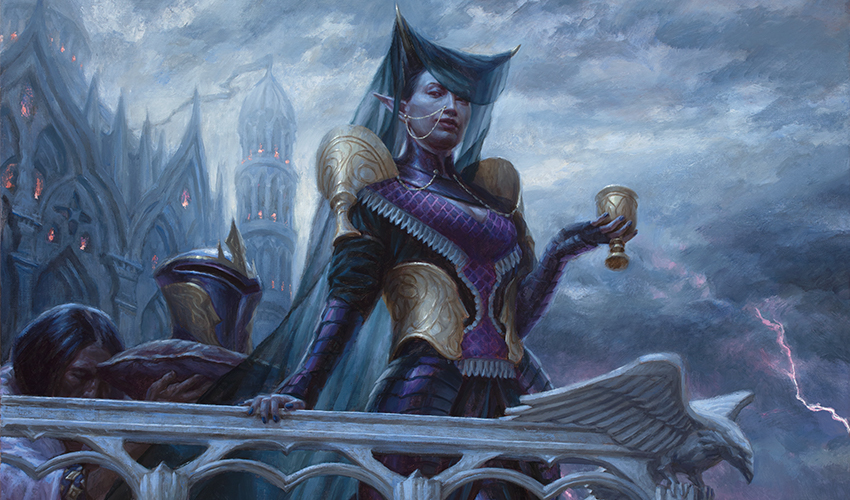
The ruler of Locthwain is Queen Ayara. Unique among the rulers of the courts, she is an elf—not an immigrant from the wilds, but the last remaining ruler of the old realm. She is unimaginably ancient, likely immortal, a form of persistence which contributes to her subjects' love for her while unnerving the people of the other courts.
While her official royal title is First of Locthwain, the denizens of the realm often refer to her as "the Widowed Queen," a reference to the many spouses she has wed over the centuries. Ayara weds the champions of Locthwain on the evening before they set out on their (ultimately fatal) quests. By tradition, a year and a day after a champion has set off on the quest, Queen Ayara declares the champion lost and holds a funeral party. More often than not, the party carries over into the next day, transforming with the new dawn into a wedding feast for the queen and her next champion-spouse.
The people of Locthwain view Ayara as a living embodiment of the virtue of persistence. Not only has she persisted (in the sense of "remained") long after the departure of the other elves from the realm, but her pursuit of the Cauldron of Eternity shows unfailing determination. By her will, the castle itself continues its forward movement, and her example inspires the people to "keep moving forward," an unofficial motto adopted by many of the court's knights.
Embereth

While nobles throughout the realm may refer to "Castle" Embereth, any who have seen it with their own eyes would be remiss to call Embereth a true castle. Indeed, the knights who call Embereth home chuckle at the misnomer. To the locals, Embereth refers to the entire surrounding free city, while the large tournament complex some call a castle is known by its "true" name: The Burning Yard.
The Burning Yard is a large collection of competition arenas, training rooms, and grandstands that hosts a never-ending tournament that features jousting, wrestling, horseback melee, one-on-one combat, archery, and other martial skills. It is a beloved destination known throughout the realm, and knights (or aspirants) from all five courts will come here to see how they stack up against the competition. Participation is open to all brave enough to enter.
Courage
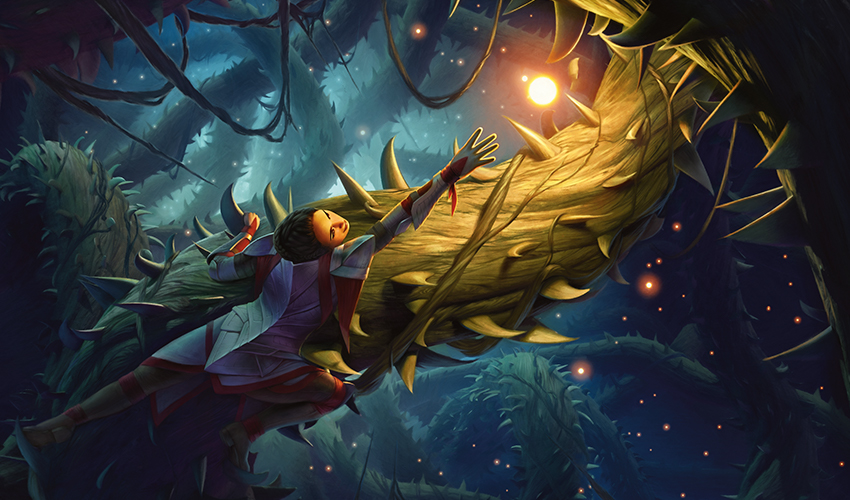
Knights of Embereth believe that courage is the highest virtue, as nothing done without bravery can truly be considered virtuous. Without bravery, no one would ever try a new thing or work to improve their skills. But with courage in one's heart, no challenge is too great.
Fear and cowardice are the enemies of valor, so Embereth's knights strive to conquer their fear. They are wise enough to know that true escape from fear is impossible and teach instead that fear is the most valuable tool. Empty courage is an easy way to get oneself killed, but true courage is knowing how to use the gift of fear as a motivator for achievement. Knights of Embereth often quote the words of Ianthe, the first Knight of the Irencrag, who said: "Fear confirms a foe is worth the end of your lance."
Knights

Embereth's knights are famously optimistic, singularly certain that anything is achievable so long as you face it head-on. They are gregarious and confident, and always willing to try new experiences, though they're not particularly long-lived. As a show of courage, Embereth knights never carry shields and often incorporate the broken shields of opponents into their armor.
Embereth's knights are intrigued by irrationally dangerous quests, believing that the most frightening challenges are the ones most worth conquering. Because of this, knights of Embereth are particularly skilled at facing supernatural dangers that would cause weaker hearts to quail. In addition to fighting monstrous threats, they also undertake quests to conquer their own personal fears. A knight might seek to slay a faerie that terrorized them as a child, a witch that took their mother, or a giant that sat on their lover's house.
The Irencrag
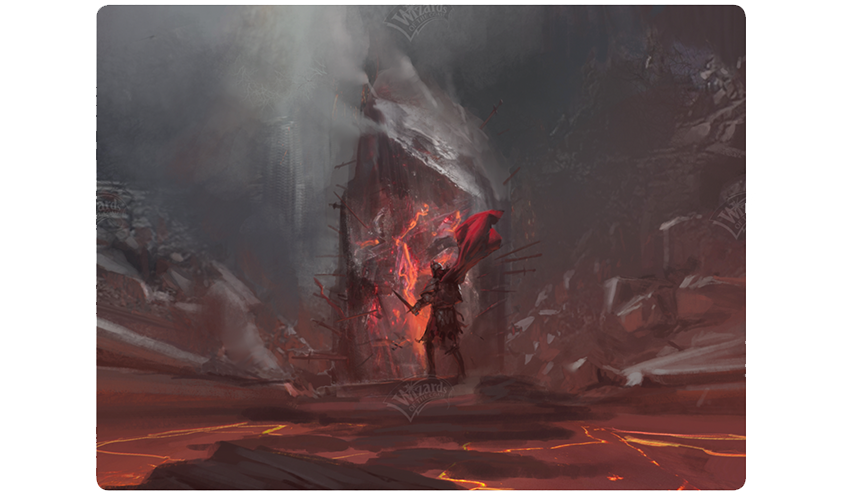
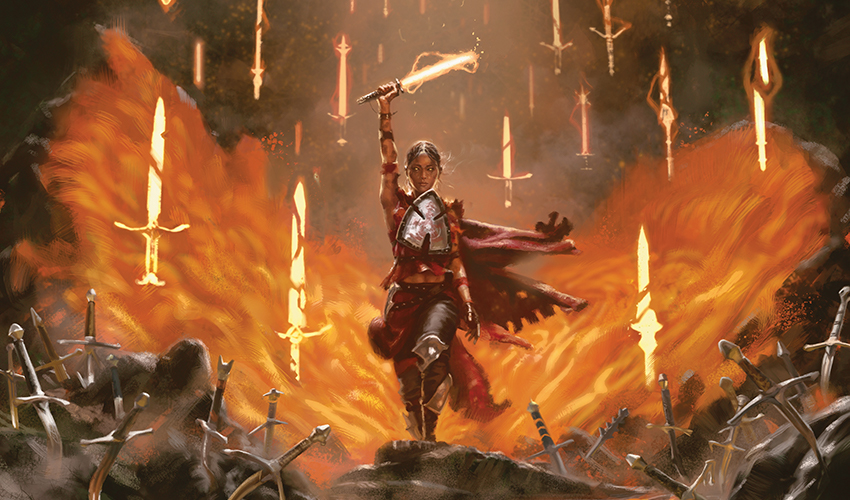
The Burning Yard is built beside the Irencrag—a massive boulder glowing with volcanic heat. In order to become a knight of Embereth, an aspirant must first face the fear inspired by its red-hot surface in order to plunge their sword into the boulder. If they are truly courageous, they can pull their sword back out, but if they are cowardly or hindered by fear, the sword remains stuck in the Irencrag.
According to Embereth knights, the Irencrag will speak to aspiring knights in a voice only they can hear, often taunting them as a test of their courage. According to legend, it was this taunting that inspired Ianthe to be the first to impale the stone with her sword. Occasionally, when the Irencrag finds a knight particularly worthy, it will bestow their sword with a legendary name, forever imbuing it with its power.
Mages who draw their power from the Irencrag must harness their emotions to wield it to its full potential. This often manifests as fire magic, but a rarer form of Embereth magic is "phobomancy," the power to harness fear. Knights can magically convert their fear into focus mid-battle or use fear to overwhelm and enervate their opponents.
Rule by Council
In place of a single ruler, Embereth has a ruling council made up of its knights and its noble class. The nobility in particular have a reputation for hotheadedness and fiery passions, which is reflected in the frequency of personal conflict "taken outside" to the Burning Yard. Even the smallest personal argument among the nobility is settled in competition or combat. Such contests are rarely fatal, and all participants readily accept the outcome as a final resolution of the dispute. As a result, grudges rarely burn for long, and most business of the council can actually be carried out with civility.
Garenbrig
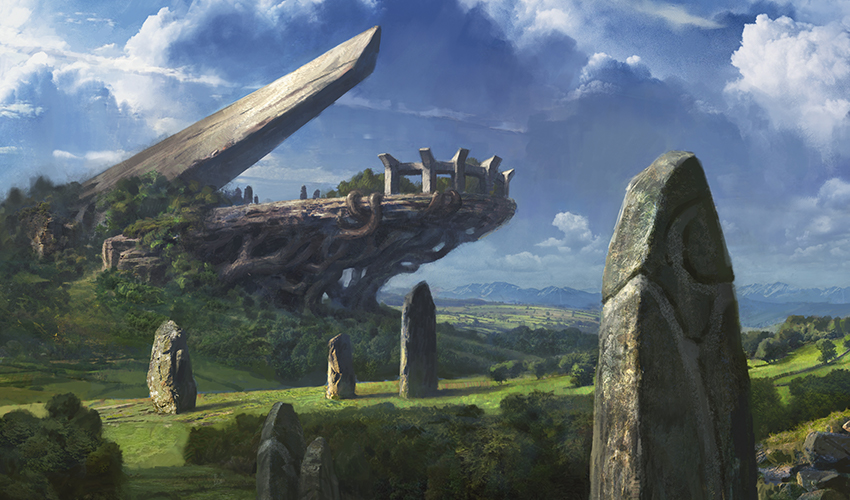
Built by giants long before the ascendancy of humans in the realm, Castle Garenbrig is an enormous and strikingly odd structure. The main bulk of Garenbrig is its relic, the Great Henge, which sits atop a jutting stone outcropping. The rest of the castle encircles the Henge at a human size and scale, making the court a harmonious fusion of giant-sized stone, human construction, and natural growth.
The large, central stone of Garenbrig forms the gnomon of a sundial. At certain times and dates, the monoliths surrounding the central stone align with the path of celestial bodies and open a temporary gateway into the deepest, darkest parts of the wilds.
Strength

Above all, the knights of Garenbrig prize raw physical strength. A Garenbrig knight should be able to wield the largest weapons, wear the heaviest armor, and perform feats of strength that border on superhuman (or supergiant, as the case may be). They also value strength of will and character—but as an addition to physical power, not a replacement.
Strength is the most external of the virtues, and this shapes the Garenbrig worldview. They view action as far more important than intention or desire and take a dim view of people who focus on their interior lives and personal virtue without actually doing anything.
Knights

To become a knight of Garenbrig, one must demonstrate a great feat of strength, something beyond the capabilities expected of their size and species. The ruler of the court is the arbiter of whether a feat of strength is worthy of knighthood, and King Yorvo is not easily impressed, so knights are hardly plentiful in Garenbrig.
Those who have earned knighthood take great pride in their strength and deploy it readily, even in pursuits that the other courts consider un-knightly. Garenbrig knights can often be found wrestling giants and fighting great beasts in the forest, but they can just as often be found carrying water in a fire brigade or clearing trees after a storm. They are fond of stories and contests in the great hall at Garenbrig, but most knights are found out in the world, helping and protecting the weak and innocent.
The Great Henge
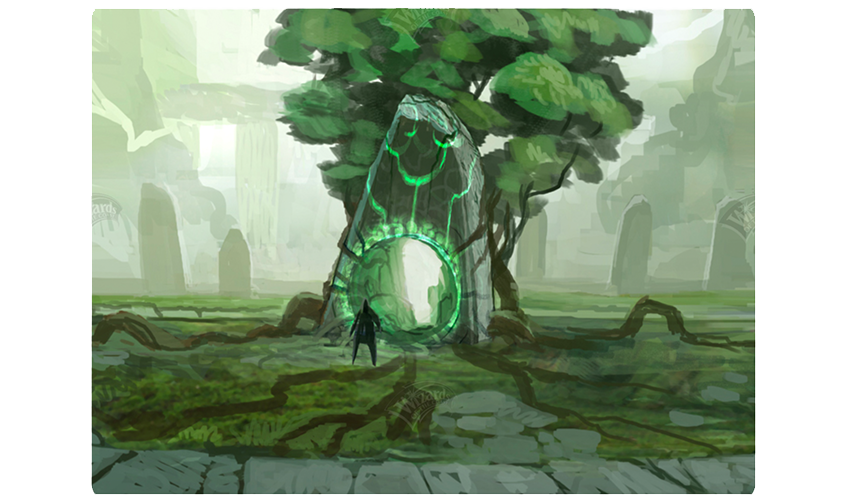
The Great Henge is a large circle of enormous stone monoliths arranged in a variety of shapes and patterns, depending on when you visit it. A singular mountainous stone slab dominates the center of the Henge and acts as the gnomon of a massive sundial. At sunrise and sunset on certain dates, the shadows of the surrounding monoliths fall in such a way that the central stone becomes a magical gate to the depths of the wilds. The surrounding calendar stones can be lifted and moved to align with the desired time and location of the journey. Moving a monolith even slightly is a great feat of strength; moving several of them to the right positions to open the portal is enough to virtually guarantee a Garenbrig knighthood. Someone who goes through at sunrise and fails to return at sunset might return in a year and a day; if they do not return then, they are likely lost forever.
Yorvo

Like most of the fair folk, giants usually reside in the wilds and keep their distance from the humans of the realm. However, some giants choose to align themselves with the court of Garenbrig. The people of Garenbrig revere giants for their tremendous strength, and the giants view Garenbrig as the worthiest heirs of their former civilization.
The current king of Garenbrig is a giant named Yorvo, who towers over even others of his kind. He wears a crown fashioned from the broken weapons of those who have challenged him to claim his position. King Yorvo's throne stands under the shelter of the gnomon stone that overhangs the court, symbolically holding up the weight of the stone and protecting the people of Garenbrig. To all the court's knights and nobles, Yorvo and his throne are a reminder of the proper use of strength: protecting those less strong than yourself.
The Wilds
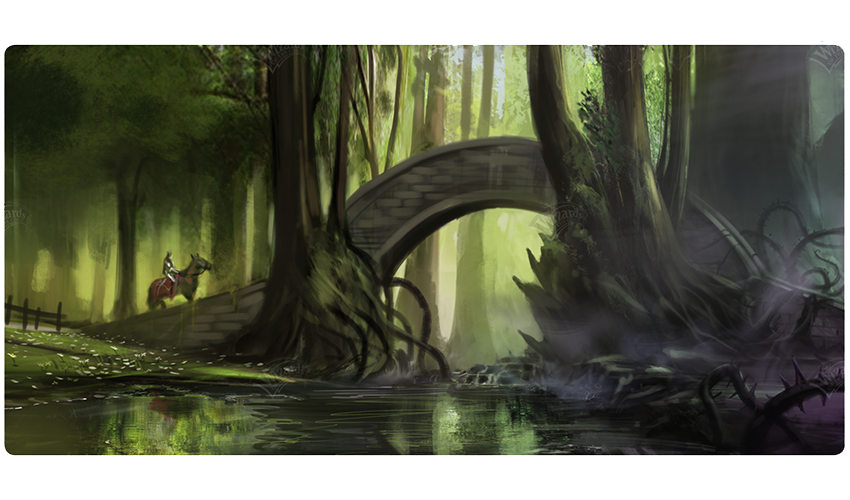
Travel far enough from the courts and castles of the realm, and you will find the world around you beginning to shift. The woods become dark and dense, as if you're being swallowed by a great beast. Thorny brambles and wildflowers grow unchecked. Small stone piles and mysterious floating lights lure you deeper in. The paths begin to dissolve or double back on themselves, and eventually your sense of direction becomes a distant dream. It is then, travelers, that you have found yourself in the wilds.
The wilds are unruly, diverse, unstructured, unpredictable, and ungoverned. Dozens of different types of creatures dwell in the wilds in an anarchic and uneasy stasis, too disorganized to go to war but too unruly to live in peace. Some are hostile to humans, some are indifferent, some are curious, and some are friendly, but a creature's species is rarely a sure indicator of their attitude.
The magic of the wilds is just as untamed and diverse as the people who live there, manifesting in strange and often beautiful ways. It can be alluring, empowering, healing, restorative, and refreshing; but it can also be repellent, enervating, and destructive. Claiming some of this magic, or even simply understanding it, is one of the primary reasons that knights of the realm undertake quests into the wilds.
Though the wilds seem unpredictable via the logic of the realm, I have personally found it to have a strange, twisted sort of internal logic, as if willed into existence by a capricious force with a cruel sense of ironic humor. Tales from the wilds can be delightful and amusing, so long as you're not the one stuck in them. On my first visit to Eldraine, a Vantress loremage shared with me a lesson that I believe helps to illustrate the absurd nature of encounters in the wilds.
"In 16 out of the last 21 Wilderfrog encounters, it was proper to politely compliment the frog and walk away, quickly and backwards. In three of the cases, the proper strategy was to immediately destroy the frog before it became a ravenous creature called a grodhemoth. One such encounter led to an illness that killed twelve Embereth knights. And finally, one frog encounter led to a long and especially joyful marriage."
The Fair Folk
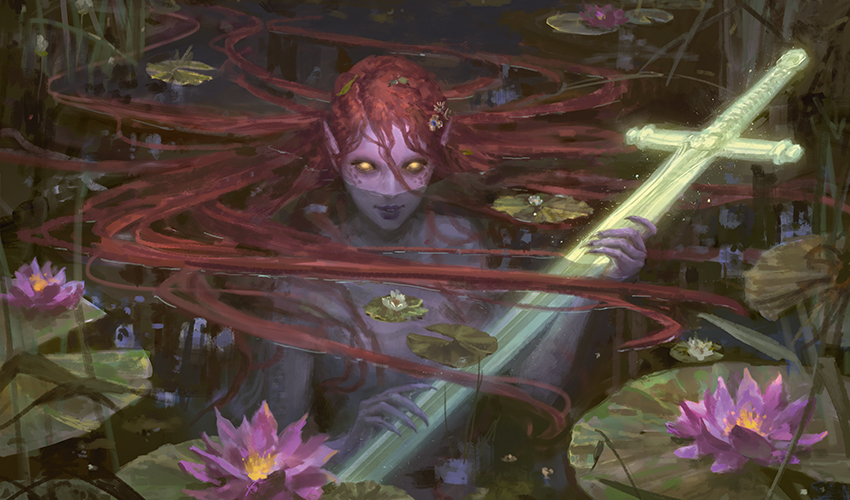
The humans of the realm refer to the magical creatures that inhabit the wilds collectively as "the fair folk." There are many different species that make up the fair folk, and even among each kind, they have individual whims and stomping grounds rather than collective goals or territory. The fair folk have their own concerns and take sudden interest or disinterest in human affairs for reasons humans find difficult to fathom.
To the realm, the fair folk appear timeless and eternal. Their various species and groups have lived in and ruled the wilds for thousands of years. They were here before humanity, and most are confident they'll be here after. Their understanding of what humans call a "crisis," "recent development," or "short while" flows from a very different sense of time.
Despite their diversity, all fair folk tend to share a common disdain for human civilization and social structures. As one faerie put it: "Virtues are dull. Knights are annoying. The king is just a person with a very impractical hat. It's funny how seriously they all take themselves. What's not funny is when they bring swords and start traipsing through my part of the woods. That's when the pranks start!" He later informed me that the best pranks usually involve at least one death.
Fae
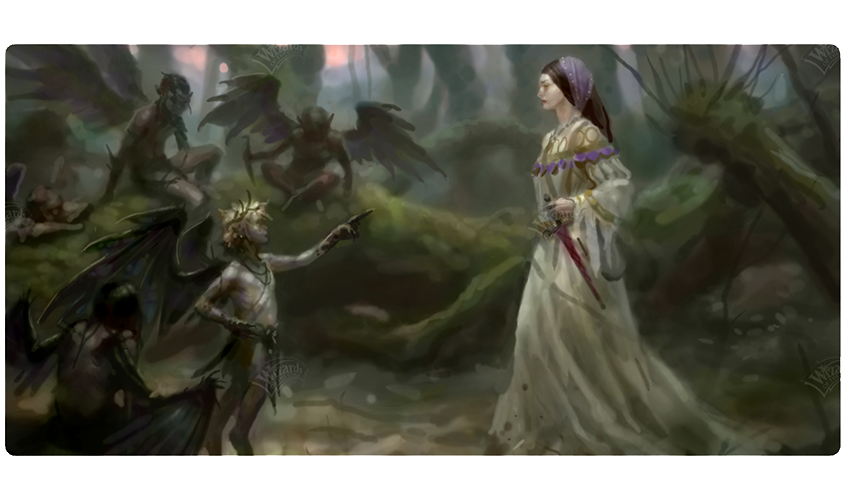
The fae of Eldraine are among the most diverse in the multiverse. Though all are winged humanoid creatures, they appear in many different shapes, sizes, and temperaments. The common thread among all fae is their love of messing with humans and their precious virtues, even when compared to other fair folk. On my journeys in the wilds, I have come across three common types of faerie, though there could be many others.
Meddling fae love to pry into human lives, either to help those in need or harm those they deem deserving. These fae are about the size of an adult human with long, flowing white garments and an eerie, angelic glow. The realm views meddling fae as the enemies of loyalty. They are fickle, helping you one day and becoming your enemy the next. Occasionally a meddling faerie will actively attempt to undermine knights' loyalty, luring them away from their company with floating lights or magical visions. Unlike other kinds of fae, meddling fae are known to sometimes be truly benevolent, helping unfortunate souls or granting desperate wishes. Still, most humans are wary to put their fates in the hands of a faerie, regardless of type.
Thieving fae steal whatever they can lay their hands on and attempt to sow confusion and frustration wherever they go. These tricksters are small, no taller than an apple, and have sharp, pointed blue wings and hair. They file stolen keys into swords and wear rags of scrap fabric torn from human clothes. Despite their size, thieving fae are cocky and boastful, always leaving marks of their crimes behind so their human victims know exactly who got the best of them. They relish in deceit and trickery; one such faerie told me her favorite pastime was lying to Vantress loremages. Thieving fae are the most common type of faerie to be found in the realm, where they enjoy infiltrating human homes and castles to pilfer their possessions.
Prankster fae have gray skin and are about the size of a human child, with sullen yellow eyes and feathery black wings. Don't let the name mislead you, a faerie prank is anything but innocent. These fae love to cause annoyance, anger, and pain to all those they encounter. They are perhaps the most mercurial of the fae and laugh at the idea of persistence. The only predictable thing about a pranking faerie is that it will always change its mind. Apparently, a faerie named Rankle has become infamous among his fellow pranksters, earning him the title of "master of pranks." Given the cruelty of the pranks I've witnessed thus far, I hope neither you nor I will ever need to learn what kind of horrible deeds it takes to earn the prankster title of "master."
Merfolk
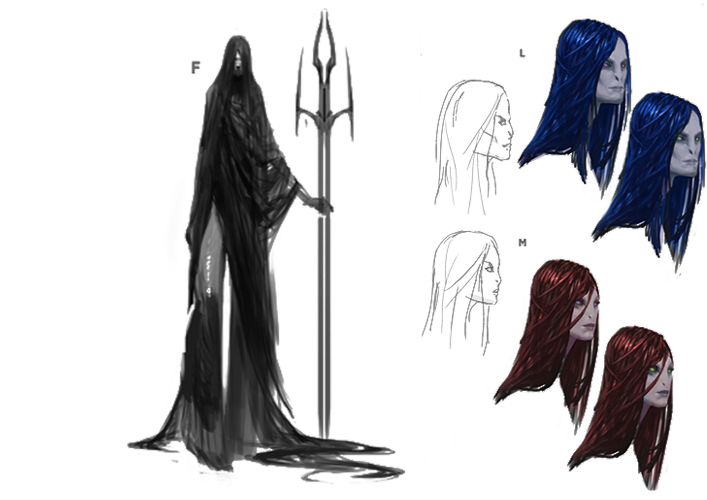
The merfolk of Eldraine are defined by their compulsive curiosity. They are obsessed with learning all they can, occasionally to the brink of madness. To the knights of Vantress, merfolk represent knowledge without virtue. Rather than seeking knowledge in service of others, merfolk hoard secrets and lord them over others. As a result, little is known about merfolk origins, customs, or magic. Their connection to knowledge and secrets leads many to take up residence in Lochmere near the Magic Mirror, which they can visit when it is fully submerged. Any potential ties between the merfolk and the Mirror remain a mystery even to those in Vantress, though they are often seen sulking in the shadows whenever human aspirants descend the spiral stairs.
Witches
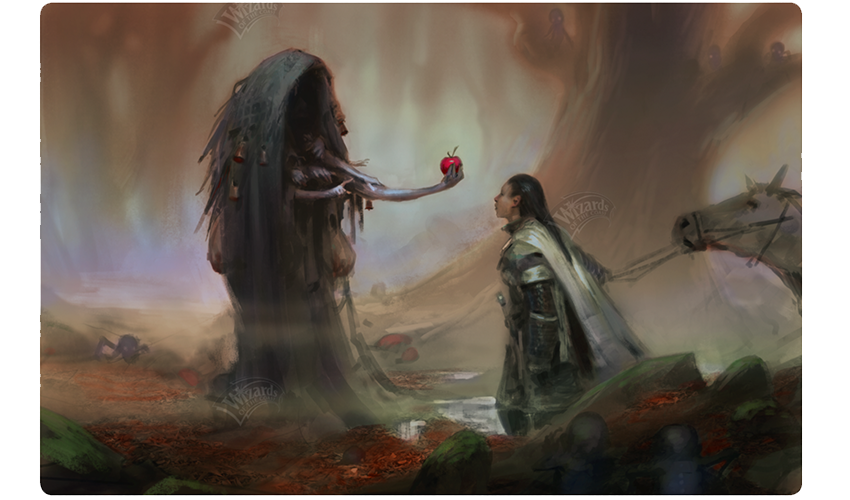
Witches are shadowy human warlocks that reside in the wilds, so disconnected from the rest of humanity that most consider them to be fair folk. Witches are considered vile and cruel, taking great joy in their evil deeds. Peasants tell stories of children stolen and baked into pies, poisoned food wiping out entire towns, and once-great knights bewitched into servitude.
Witches place curses on those who wrong them, which can only be broken when the victim makes some kind of atonement. They turn the gluttonous into swine, the lazy into sloths, and the treacherous into weasels. In a way, they are a dark power of justice in the world, though the people of the realm are loath to agree.
Dwarves
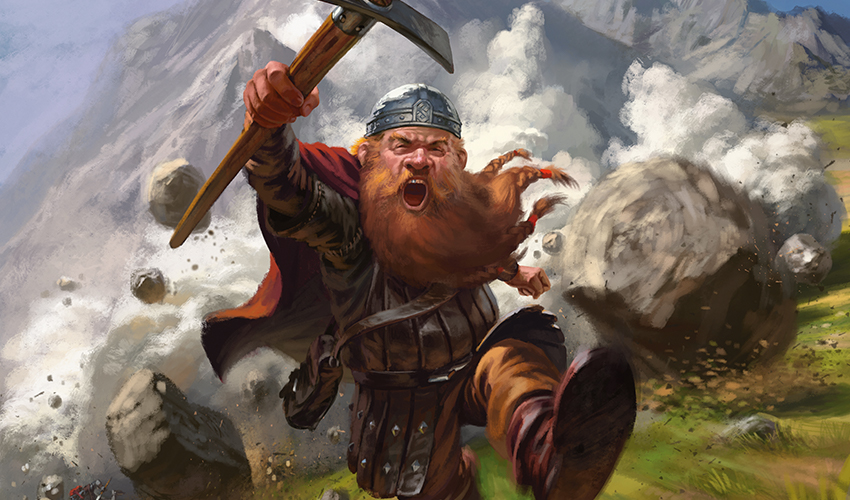
Dwarves are industrious artisans who value hard work and independence. They are miners and jewelers, and control over natural resources is an important aspect of dwarf society. Dwarves create intricate jewelry and sturdy weapons from the minerals they dig up. Occasionally they sell what they find to the courts of the Realm. Dwarves take pride in the things they make and value the dignity of work.
While most dwarves highly value their individual ability to take care of themselves and pull their own weight, most ultimately prefer strength in numbers. Dwarves usually choose to live in tight-knit family groups that hold claim to mineral deposits. Each vein of gold or cave of sapphires is controlled by a different clan of dwarves. Dwarf households are underground, carved out of massive crystal and gems and far away from natural light sources. No human has ever laid eyes on the inside of a dwarf burrow, but rumor has it the underground houses are carved out of rubies and emeralds as large as boulders.
Torbran
The majority of dwarves are put off by the hierarchy and stuffiness of the human courts and prefer to live out in the wilds. For a few individual dwarves, the fearless camaraderie of the Court of Embereth appeals to them. These dwarves, driven by the independence so valued by their clans, sometimes pack up for a few years to compete at the Burning Yard, often bringing with them dwarf-forged armor and weapons that give them an edge in combat.
One such dwarf was Torbran, the current Thane of the dwarvish clan of Red Fell. As the story goes, Torbran traveled to Embereth in his youth to compete for knighthood. Though he defeated each foe he faced, when the time came to claim his prize and strike the Irencrag, Torbran refused. According to him, the Irencrag had insulted the craftsmanship of his weapon in its taunts (which I'm told is quite a personal offense in dwarvish culture). Unwilling to give the stone the satisfaction of tasting his blade, Torbran left Embereth and returned to the wilds. Some in Embereth consider Torbran a coward for leaving, but many others believe that Torbran will one day return to claim his rightful knighthood. They believe he has spent the past few decades crafting a weapon of such quality and power that it will strike fear into the Irencrag itself.
Redcaps
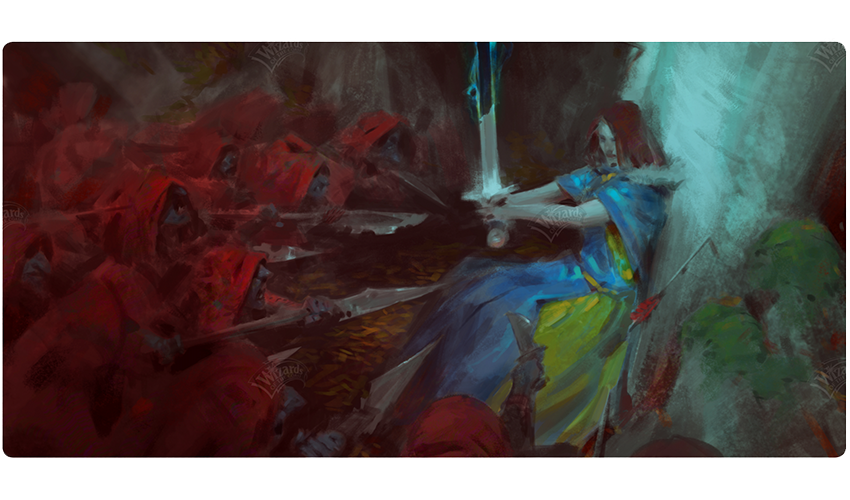
Redcaps (the name given to the goblins of Eldraine) are mischievous agents of chaos, standing about as tall as a barrel, with distorted features and red hair stained with the blood of their enemies. Redcaps fight without any sense of honor or fair play, specializing in sneak attacks and ambushes. They often launch raids into villages near the edges of the wilds. Redcaps are fierce and reckless in battle, reveling in disrupting human order by instilling fear and chaos. In the realm, redcaps are thought to be entirely lacking courage; they rely solely on cowardly tactics like backstabbing and only ever fighting if they outnumber their opponents.
One Vantress knight told me that the best way to deal with a redcap is to wash the blood off its head with magical water. I haven't yet had the opportunity to test this method myself, though, honestly, I can't say I've tried all too hard to personally seek the creatures out.
Giants
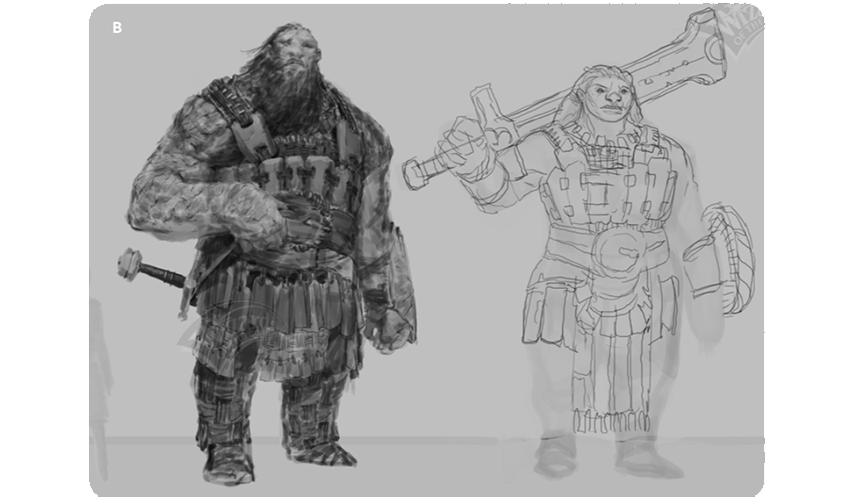
Like the fae, giants on Eldraine come in a variety of shapes and sizes. All giants are incredibly large humanoids and possess magical strength that goes beyond even what their great size would suggest. Smaller giants stand around 10 feet tall. These giants often have skin made of bronze and use their immense strength to bully small folk.
Larger giants can stand 15 feet tall. These giants have skin of stone, often covered with naturally growing moss. These giants tend to be kinder to small folk, using their strength to help those in need. This outlook on life sometimes inspires them to become knights of Garenbrig. In battle, giant knights ride armored mammoths and specialize in wielding clubs and axes longer than a tree is tall.
Giants live in both the realm and the wilds. Some giants view the humans' quest after five noble virtues as a commendable effort and are willing to ally with humans so long as their goals are not in conflict. Others believe that clinging to virtues like knowledge and loyalty makes humans weak, and they have no interest in aligning with the courts. Still other giants cling to ancient grudges, citing the humans' conquest of the realm as proof that they can't be trusted.
Elves

Among the fair folk, elves are most home in the deep forests of the wilds. They are adept at hiding among the trees and attuned to the mana of the forests. Most elves are lithe and stand just shorter than a human, with a range of skin tones and tall, pointed ears. Due to their innate connection to the natural world, elves often patrol the forests as rangers, archers, scouts, and druids.
The elves remember being driven from their realm (in fact, some living individuals were alive at the time). Resentment lingers in their hearts, but they are not bitter enemies. Encounters between elves and humans do not always erupt in violence, but they are never warm. Some elves actively hunt humans, just as they hunt deer and boars in the forest.
The elves retain the regal bearing and pride of the realm's ancient rulers despite their life in the wilds, but they also mock the pretensions of human nobility. Elves are often seen wearing mock crowns made of natural substances like ferns, flowers, and branches. Some elves call themselves knights, though the realm would not recognize them as such. They ride giant foxes and wolves so they can bound through dense forests faster than any horse.
Elvish druids, respected for their wisdom, are the leaders of elf bands. When situations arise that concern the elves as a group, a council of all the druids convenes to solve the problem. No single druid holds authority over the council, but by longstanding tradition, the five eldest druids hold seats of honor—representing the five magical sites of their ancient realm. The druids strive for consensus rather than simple majority rule. Unfortunately, this means that it can sometimes take so long to reach a decision that the situation escalates into a crisis.
The Questing Beast
The Questing Beast is a large, three-headed creature that lives deep in the heart of the wilds. Despite trusting its judgement of character, very few in the realm have seen the Beast itself, for it only appears to the select few individuals it chooses to undertake in the High Quest. I've heard many conflicting reports on what the Beast looks like and the myriad of magical powers it possesses. The only point of consensus seems to be that the beast has three heads which are never in alignment. For every question you ask of the Beast, each of its heads will give you a different cryptic answer, leaving you to piece together the full truth on your own. If you'd like to learn more, you'll have to ask the King and Queen yourself.
